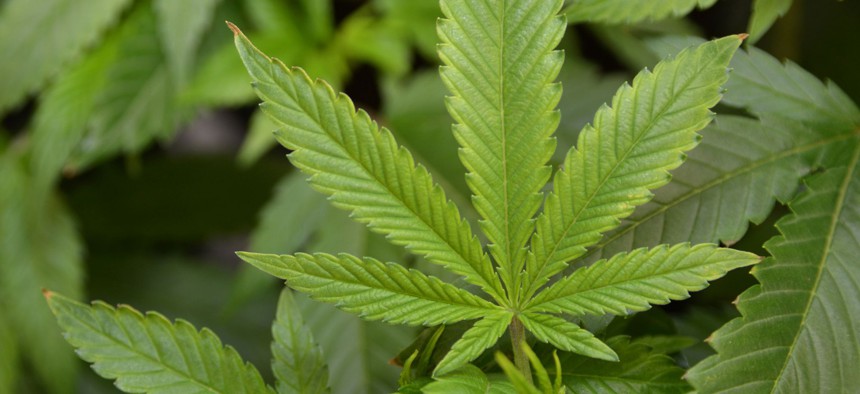Patients Are Ditching Opioid Pills for Marijuana

Shutterstock

Connecting state and local government leaders
Can marijuana help solve the opioid epidemic?
James Feeney, a surgeon in Connecticut, heard it from his patients. A few actually turned down his prescription for oxycodone, the popular opioid painkiller that has also gained notoriety with the opioid epidemic. His patients, Feeney recalls, would say, “Listen, don’t give me any of that oxycodone garbage. … I’m just going to smoke weed.”
“And you know what?” says Feeney. “Every single one of those patients doesn’t have a lot of pain, and they do pretty well.”
Marijuana has worked well enough, anecdotally at least, that Feeney is following his patients’ lead and conducting a trial at Saint Francis Hospital and Medical Center in Hartford, Connecticut. The self-funded study will compare opioids and medical marijuana for treating acute pain, such as that from a broken rib.
That distinction—acute pain from an injury—is also an important one. A small body of evidence suggests that medical marijuana is effective for chronic pain, which persists even after an injury should have healed and for which opioids are already not a great treatment. But now Feeney wants to try medical marijuana for acute pain, where opioids have long been a go-to drug.
“The big focus from my standpoint is that this is an attempt to end the opioid epidemic,” he says. Overdoses from opioids, which includes heroin as well as prescription painkillers like oxycodone and morphine, killed more than 30,000 people in 2015.
Marijuana might have a bigger role in curbing this drug abuse than previously thought. Its potential uses are actually threefold: to treat chronic pain, to treat acute pain, and to alleviate the cravings from opioid withdrawal. And it has the advantages of being much less dangerous and addictive than opioids.
The big roadblock? Marijuana’s status under federal law as a Schedule I drug—the most tightly restricted category—which makes it very difficult for researchers to study. Scientists first have to apply for a license from the Drug Enforcement Administration, which “can take people years,” says Yasmin Hurd, a neuroscientist at Mount Sinai who has a license to study marijuana and its derivatives. Another problem is sourcing. Scientists can only get marijuana from a farm at the University of Mississippi, which grows a limited variety. “You want to be able to study different formations, but if you can only get the compounds from one source, that makes it hard,” says Hurd.
This is especially relevant to Hurd’s work because her interest is not necessarily THC, the psychoactive chemical in marijuana, but cannabidiol, also known as CBD. Cannabidiol doesn’t get you high, but it affects the receptors in your brain more indirectly. In a small pilot study, Hurd has found that cannabidiol can reduce the cravings of people addicted to heroin. “They relapse because they are in conditions that induce craving,” says Hurd. By controlling their anxiety, cannabidiol also seems to be controlling their cravings.
Hurd is now running a larger trial to investigate if the substance could help people addicted to heroin, and she published a recent review on cannabidiol’s role in curbing substance abuse.
Using marijuana to treat chronic pain is a more established idea. A 2015 review of 28 randomized clinical trials found “moderate-quality evidence” that compounds derived from marijuana or synthetic versions thereof were beneficial.
Interestingly, patients already seem to be replacing opioids with marijuana for chronic pain. A handful of observational studies have also found correlations between states legalizing medical marijuana and a drop in painkiller prescriptions, opioid use, and deaths from opioid overdose. And in 2016, Dan Clauw and his colleagues published a survey of patients with chronic pain who started patronizing a medical marijuana dispensary. They cut their previous opioid use by two-thirds.
“They felt a lot better when their pain was being controlled by cannabis rather opioids because opioids have a lot of side effects,” he says. Those side effects include dizziness, constipation, sexual dysfunction and—in the case of overdoses—breathing problems. That’s because opioids receptors are also in the brainstem, the part of the brain that regulates breathing. Marijuana acts on a different set of receptors.
Clauw, who runs a pain lab at University of Michigan, says he would to like understand how marijuana quells pain on a molecular level, but getting the license has proved too big a hurdle.
Meanwhile, Feeney’s hospital trial for acute pain is able to get around the logistics issue of marijuana as a scheduled substance. Medical marijuana is legal in the state of Connecticut, but neither Feeney nor his hospital provides it directly to patients. Rather, a doctor certifies a patient to use marijuana, and the patient then picks it up at a dispensary or pharmacy. “The strains I have to select from are so pure and so potent that the stuff they get from the University of Mississippi pales in comparison,” says Feeney.
The trial, which was just got started, will enroll 60 patients with rib injuries in total—30 on marijuana, 30 on opioids. The doctors chose rib injuries to study because the pain lasts a predictable six weeks. Because of the study’s design, patients get to choose whether they use opioids and marijuana to control pain. So far, the hospitals has enrolled a handful of patients. They’ve all chosen marijuana.
Sarah Zhang is a staff writer at The Atlantic, where this article was originally published.

NEXT STORY: Cleveland’s ‘Moral Dilemma’ on Lead Poisoning; ‘We Just Don’t Have the Money’ in Kansas




